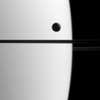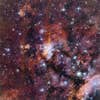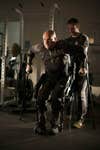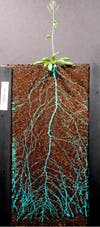Entering The Eye of An Algal Storm
This detailed image of an algal bloom was captured this past month by the Sentinel-2A. Algal blooms occur when a large amount of algae accumulates in one specific area. These blooms occur in both fresh and salt water. The image shows the algal bloom in incredible detail. If you look closely in the center, you can see a ship entering the “eye of the algal storm,” with the ship’s wake seen as a straight dark line as it jetted through the green algae.
A Transit In Action
The Cassini spacecraft captured this near perfect example of a transit this past May. A transit occurs when one celestial body moves in front of another celestial body. This particular transit occurred as Saturn’s moon Dione crossed in front of the planet. Scientists use transits to accurately determine the orbital parameters of Saturn’s moons.
A Stellar Nursery
For a star, being in your first few million years of life still makes you a newborn. A telescope at La Silla Observatory in Chile captured a cluster of three newborn stars situated within the Prawn Nebula. The image of this stellar nursery, which is situated 6,000 light-years from Earth, shows many clusters of hot, newborn stars.
Harbor Seal Photobombs The Milky Way
Astrophotographer Stephen Ippolito took this photo of the amazing Milky Way Galaxy as it rested over Sand Beach in Acadia National Park in Main only to find that a Harbor Seal had stolen the shot. Ippolito told Space.com that the two of them together in one photo left him in awe.
Fuzzy Cancer
Understanding the mechanisms that enable a few cancer cells to turn into a malignant tumor could help researchers understand and treat cancer more precisely. To assist, a team of researchers developed a 3D model of how cancer cells form a tumor—complete with different colors that represent unique genetic mutations.
A Chariot Of Drones
“Swarm Man” – the name given to a drone made out of 54 counter-rotating propellers, all linked together in a hexagonal formation – took off on a test run this week and reached heights comparable to that of a young child on a basketball player’s shoulders. While the craft is functional, it appears it was built more for novelty than for any functional purpose.
A Paralyzed Man Takes Steps
Pictured here in his bionic suit during a training session, Mark Pollock, who was paralyzed four years ago from the waist down, did something not even most doctors thought was possible: With the help of a bionic suit and a non-invasive stimulation technique, he voluntarily took thousands of steps. He is reportedly the first completely paralyzed person to accomplish this feat.
Glowing Roots
A plant’s roots are one of the hardest structures of a plant for scientists to study. Unlike their leaves, the roots remain hidden in the soil and scientists must dig them up in order to study them. Now, a team of scientists at The Carnegie Institution for Science, figured out a way to study roots without taking them out of the ground by genetically engineering the plants to produce a bioluminescent called luciferase. Then using a light sensitive camera and custom built vessels they can achieve an image like the one pictured of a mustard plant’s root system.
Make Way For Wildlife
This week was definitely a win for cougars and other wildlife living near Highway 101 in Los Angeles County. A proposed plan to build an overpass on top of Highway 101 to allow wildlife to cross was announced to be feasible by the California Department of Transportation this week. If built, the overpass would cross 10 lanes of traffic and would cost between $33 and $38 million.
A Cat’s Point Of View
If you’ve ever wondered what a cat’s point of view is like, you’re in luck. A new project by Japan’s Hiroshima prefecture allows you to explore the small town of Onomichi, Japan—which is heavily populated by cats. This image is a screenshot of the new project, which can be likened to Google Street View, but for cats.











